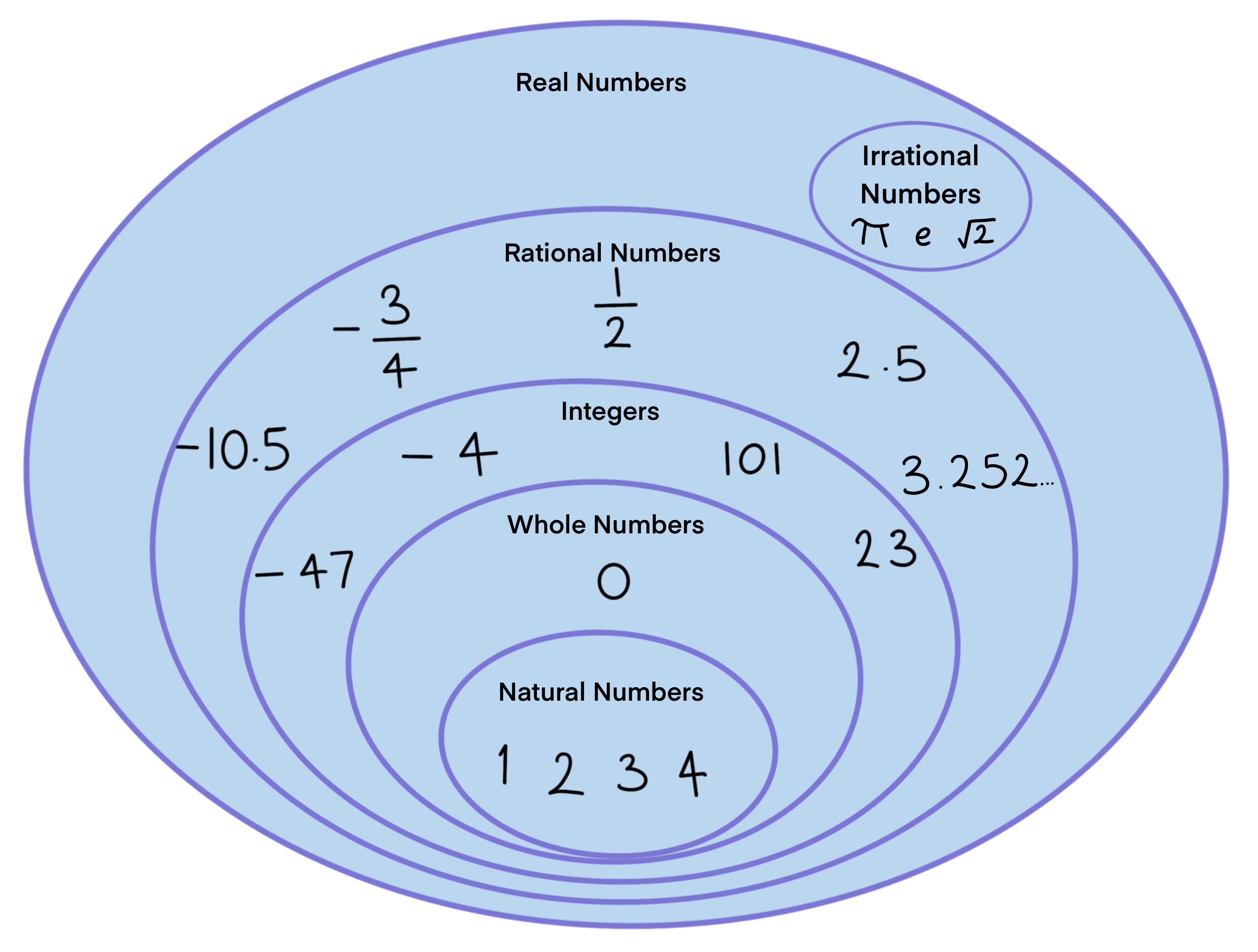A number system is made up of different types of numbers that all have a certain property or properties. There are many different types of number systems:
Natural (or counting) numbers
A natural number can be described as a positive whole number, they start from 1 and go onwards; 1, 2, 3, 4...
Natural numbers can be represented on a number line;
 Natural Numbers, Thomas-Gay - StudySmarter Original
Natural Numbers, Thomas-Gay - StudySmarter Original
Whole numbers
Whole numbers are all of the natural numbers plus zero. They start at 0 and go onwards; 0, 1, 2, 3, 4...
Whole numbers can also be represented on a number line;
 Whole Numbers, Thomas-Gay - StudySmarter Originals
Whole Numbers, Thomas-Gay - StudySmarter Originals
Integers
An integer includes both positive and negative whole numbers, as well as zero. They include
Integers can be shown on a number line;
 Integers, Thomas-Gay - StudySmarter
Integers, Thomas-Gay - StudySmarter
Rational numbers
A rational number can be written as a fraction, , where and are both integers and is not equal to 0. A decimal that terminates or has an indefinite repeating pattern can also be considered a rational number.
Irrational numbers
Irrational numbers are numbers that cannot be written in the form , where and are both integers and does not equal 0. An irrational number is a number that doesn't have a terminating or reoccurring decimal.
The most well known example of an irrational number is pi (), this is a number that has a decimal that goes on forever without repeating any pattern;
Complex numbers
A complex number can be written in the form , where and are both real numbers and is an imaginary unit.
Real number system
The real numbers include all rational and irrational numbers, and thus all natural numbers, whole numbers, and integers. This can be shown in the diagram below, this is a Venn diagram where which indicates how they all link to one another;

Number Systems, Thomas-Gay - StudySmarter Originals
This diagram shows that each subset fits within the larger set, for example, it shows that all rational numbers are real numbers, and so on. All integers are rational numbers and real numbers. Since the natural numbers set sits within all of the other subsets, a natural number can be considered a whole number, integer, rational number and a real number.
It is useful to be able to identify which type of number it is that you have been given.
Which number system or systems does belong to?
Solution:
To identify this you are able to use your calculator to solve the square root to see what type of number it is;
Since the decimal does not terminate or repeat, this is an irrational number.
To which number system or systems does belong to?
Solution:
Once again you can solve the square root to identify the type of number;
Since is equal to 8, belongs to the number systems of, natural numbers, whole numbers, integers and rational numbers.
Graphing real numbers
To graph real numbers simply means to place them in order on a number line. There are different indicators that can be added to the number line to represent the set of numbers that are being graphed. Let's work through some examples to explore each of these indicators;
Graph the set of numbers
Solution:
To do this you need to first start by drawing a number line, the first number that is included is 1. To show that x could equal one you draw a filled dot above the number. Since there is no end to the graph, rather than drawing all of the numbers onto the graph you can simply draw an arrow going past the last number to indicate it is continuing;
 Graphing real numbers example, Thomas-Gay - StudySmarter Originals
Graphing real numbers example, Thomas-Gay - StudySmarter Originals
Graph the set of numbers id="2600988" role="math"
Solution:
For this example you need to first start by drawing your number line, then you can begin to input the information. Since this time x is smaller than 10 but does not include 10, the circle above 10 will not be colored in.

Graphing real numbers example, Thomas-Gay - StudySmarter Originals
Graph the set of numbers
Solution:
For this example you need to first start by drawing your number line, then you can begin to input the information. Since the x is smaller than and includes , the circle above will be colored in.

Graphing real numbers example, Thomas-Gay - StudySmarter Originals
Graph the set of numbers
Solution:
To begin with, draw out your number line, then you can start to input the information. Since x is bigger then or equal to -6, the circle above the -6 should be colored in.

Graphing real numbers example, Thomas-Gay - StudySmarter Originals
Number Systems - Key takeaways
- Numbers can belong to the set of whole numbers, integers, rational numbers, irrational numbers, real numbers and complex numbers.
- Rational numbers are numbers that are represented as a fraction, in the form , where a and b are integers and , a terminating or a reoccurring decimal.
- Irrational numbers have a decimal that do not terminate with no repeating pattern.
- Complex numbers are written in the form, , where a and b are real numbers and i is the imaginary unit.















